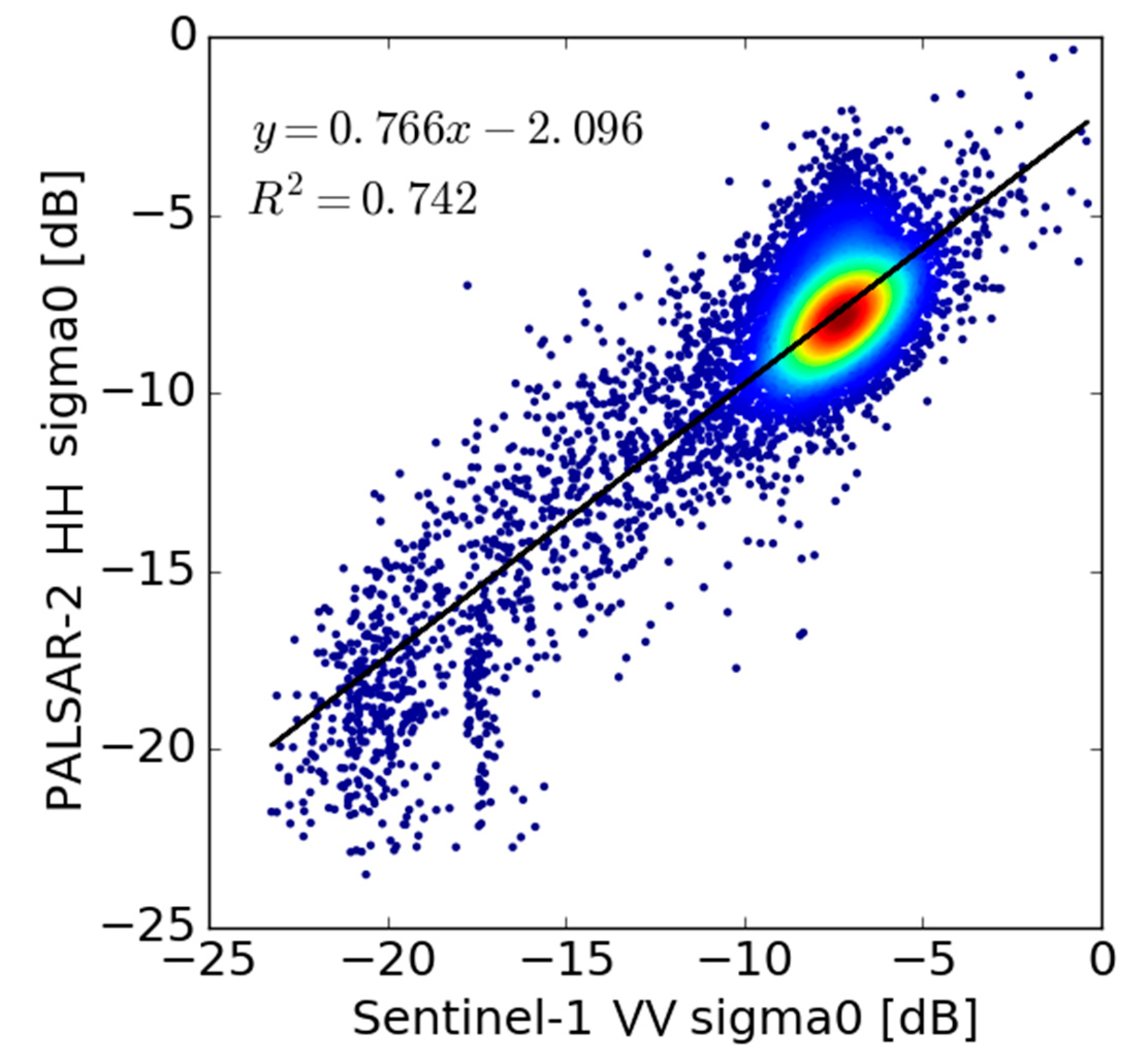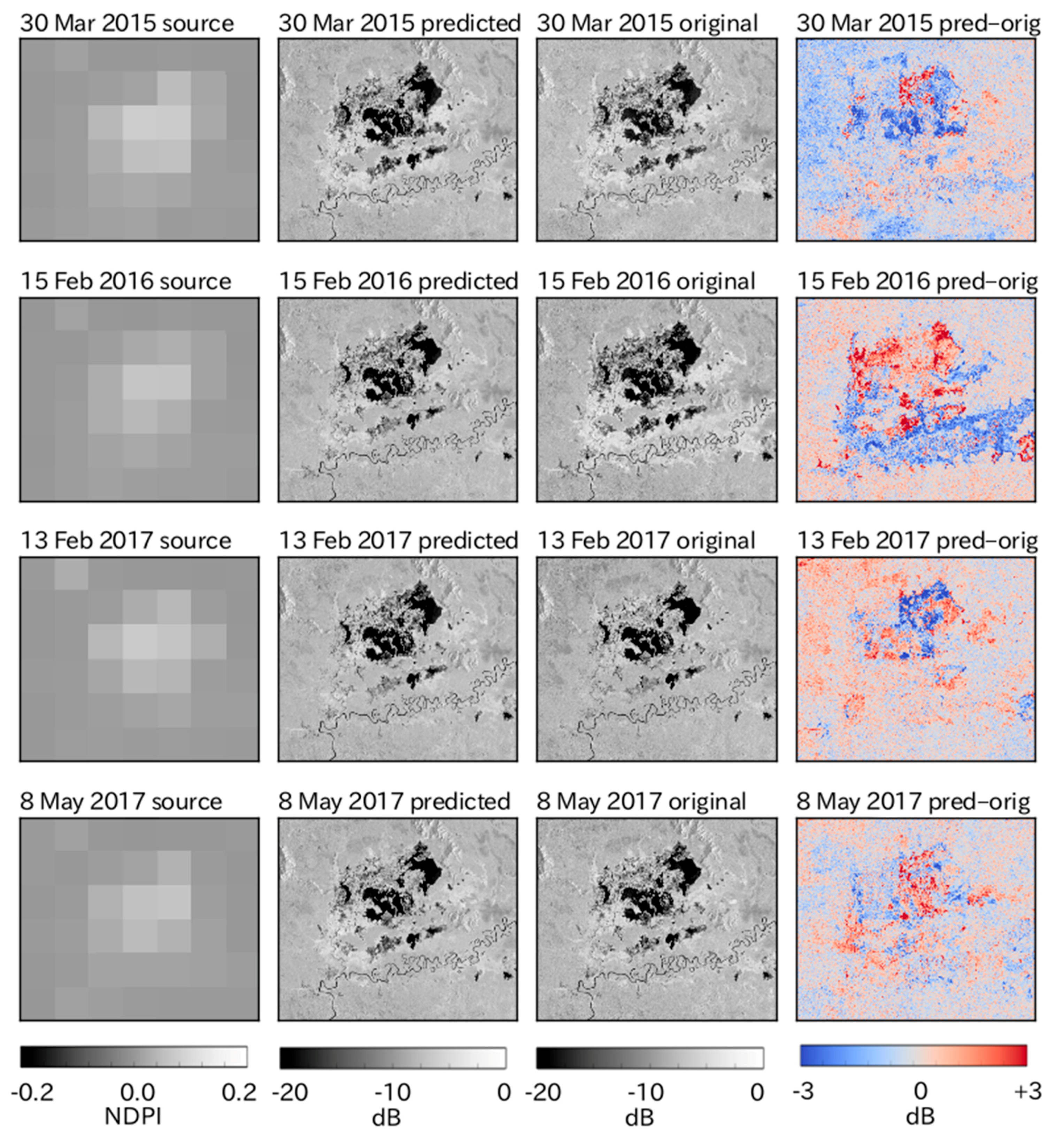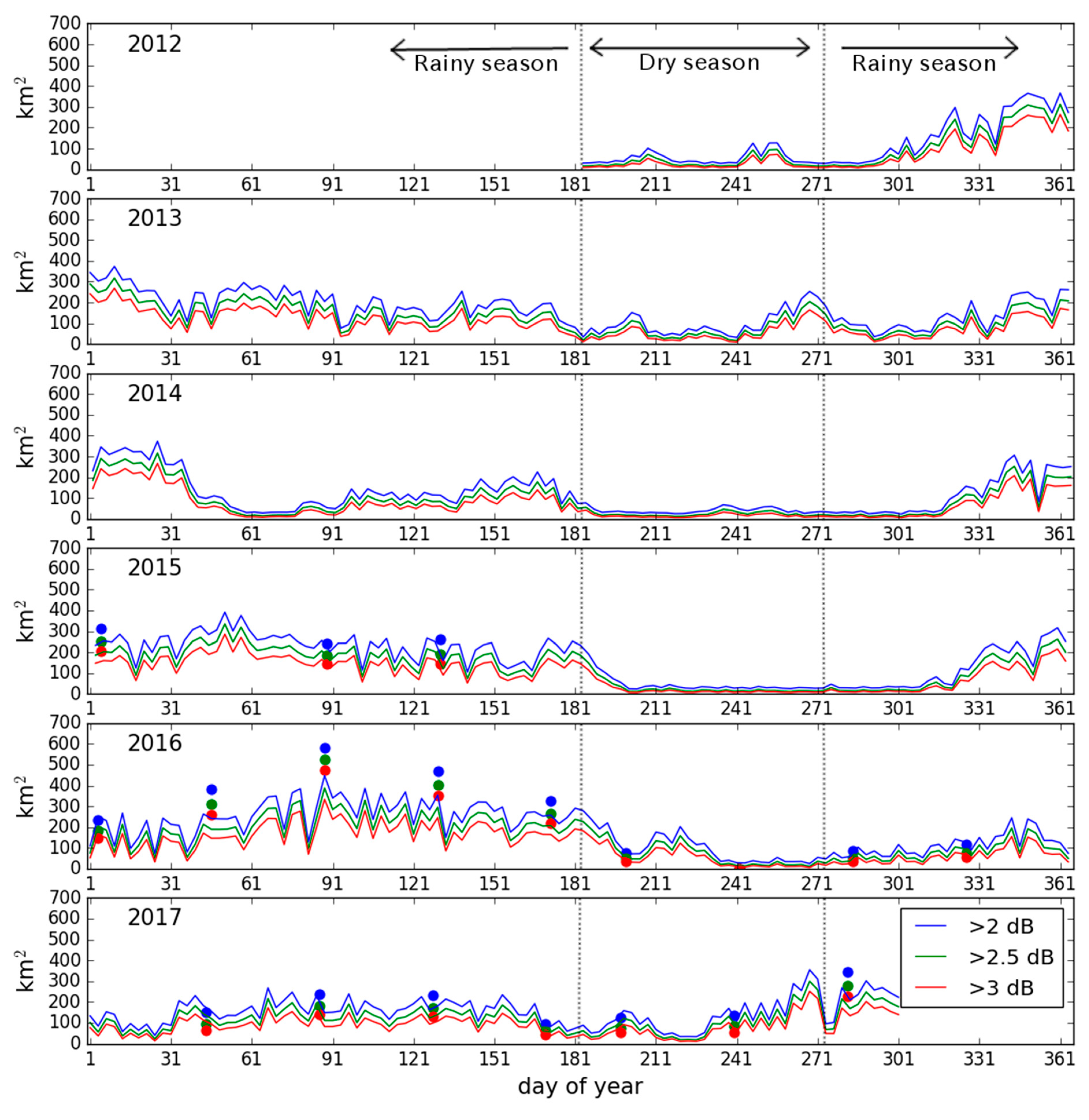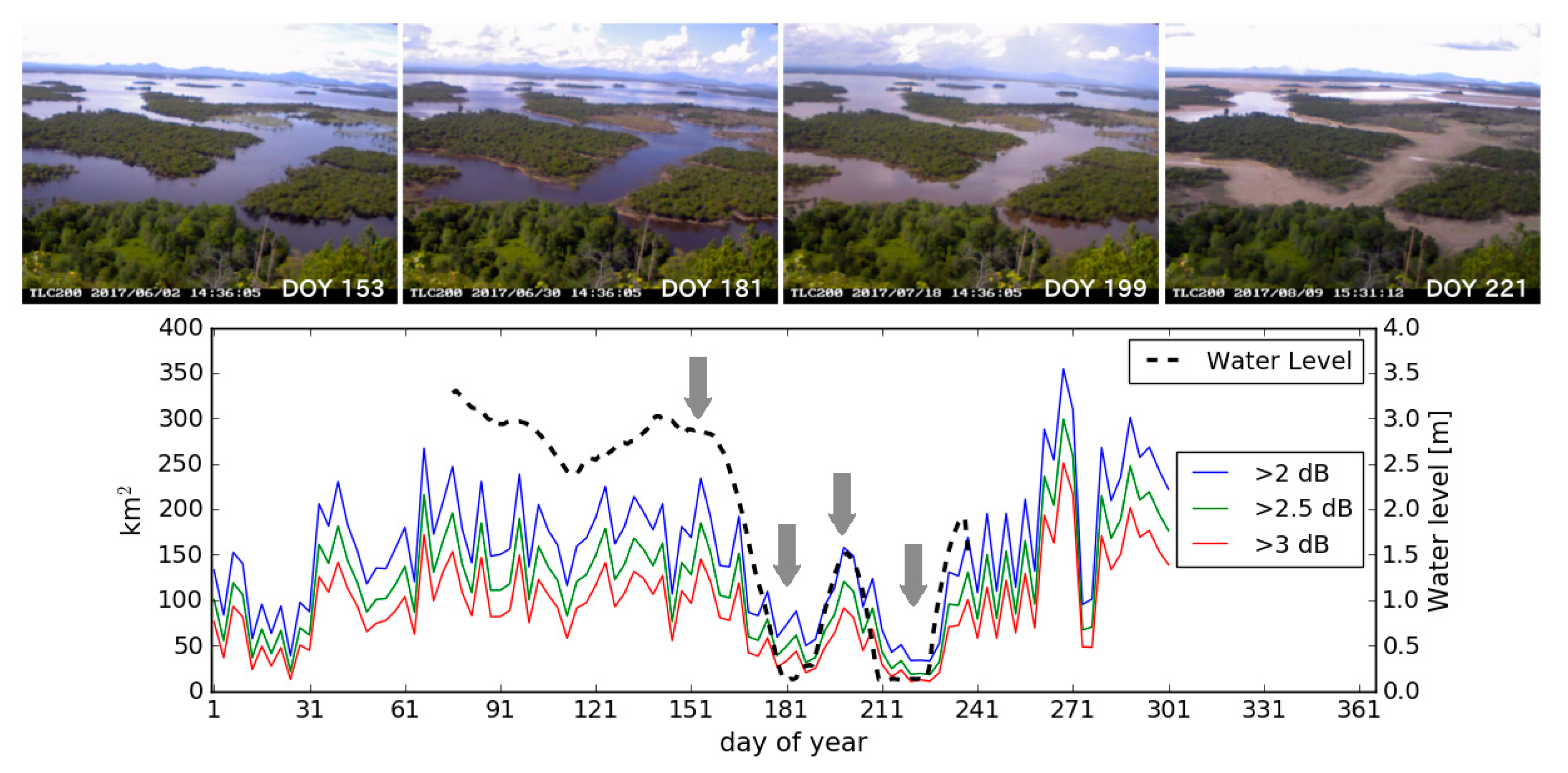Monitoring of an Indonesian Tropical Wetland by Machine Learning-Based Data Fusion of Passive and Active Microwave Sensors
Abstract
1. Introduction
2. Materials and Methods
2.1. Study Site and Period
2.2. Pre-Processing of Satellite Data
2.2.1. AMSR2
2.2.2. PALSAR-2
2.3. Training of Random Forest Database Unmixing (RFDBUX)
2.4. Cross-Validation
2.5. Long-Term Prediction
2.6. Additional Experiments
2.6.1. Integrated use of Sentinel-1
2.6.2. Use of DOY
2.6.3. Use of precipitation
3. Results
4. Discussion
5. Conclusions
Author Contributions
Funding
Acknowledgments
Conflicts of Interest
References
- Anshari, G.; Kershaw, A.P.; van der Kaars, S.; Jacobsen, G. Environmental change and peatland forest dynamics in the Lake Sentarum area, West Kalimantan, Indonesia. J. Quat. Sci. 2004, 19, 637–655. [Google Scholar] [CrossRef]
- Klepper, O.; Asmoro, P.; Suyatno, N. A hydrological model of the Danau Sentarum floodplain lakes. In Tropical Limnology; Schiemer, F., Boland, K.T., Eds.; SPB Academic Publishing: Amsterdam, The Netherlands, 1996; pp. 267–275. [Google Scholar]
- Dennis, R.; Erman, A.; Stolle, F.; Applegate, G. The Underlying Causes and Impacts of Fires in South-East Asia; Site 5. Danau Sentarum, West Kalimantan Province, Indonesia; Center for International Forestry Research, International Center for Agroforestry Research, United States Agency for International Development, US Forest Service: Washington, DC, USA, 2000.
- Ridwansyah, I.; Nasahara, K.N.; Nishiyama, C.; Subehi, L. Land Use Change Analysis at Sentarum Catchment Area, West Kalimantan-Indonesia. In Proceedings of the 16th World Lake Conference, Bali, Indonesia, 7–11 November 2016; pp. 222–231. [Google Scholar]
- Welcomme, R.L. River Fisheries; Technical No. 262; FAO: Rome, Italy, 1985; p. 136. [Google Scholar]
- Hidayat, H.; Teuling, A.J.; Vermeulen, B.; Taufik, M.; Kastner, K.; Geertsema, T.J.; Bol, D.C.C.; Hoekman, D.H.; Haryani, G.S.; Van Lanen, H.A.J.; et al. Hydrology of inland tropical lowlands: The Kapuas and Mahakam Wetlands. Hydrol. Earth Syst. Sci. 2017, 21, 2579–2594. [Google Scholar] [CrossRef]
- Guo, M.; Li, J.; Sheng, C.; Xu, J.; Wu, L. A review of wetland remote sensing. Sensors 2017, 17, 1–36. [Google Scholar] [CrossRef] [PubMed]
- Twele, A.; Cao, W.; Plank, S.; Martinis, S. Sentinel-1-based flood mapping: A fully automated processing chain. Int. J. Remote Sens. 2016, 37, 2990–3004. [Google Scholar] [CrossRef]
- Clement, M.A.; Kilsby, C.G.; Moore, P. Multi-temporal synthetic aperture radar flood mapping using change detection. J. Flood Risk Manag. 2017, 11, 152–168. [Google Scholar] [CrossRef]
- Martinis, S.; Plank, S.; Ćwik, K. The Use of Sentinel-1 Time-Series Data to Improve Flood Monitoring in Arid Areas. Remote Sens. 2018, 10, 583. [Google Scholar] [CrossRef]
- Manjusree, P.; Prasanna Kumar, L.; Bhatt, C.M.; Rao, G.S.; Bhanumurthy, V. Optimization of threshold ranges for rapid flood inundation mapping by evaluating backscatter profiles of high incidence angle SAR images. Int. J. Disaster Risk Sci. 2012, 3, 113–122. [Google Scholar] [CrossRef]
- Henderson, F.M.; Lewis, A.J. Radar detection of wetland ecosystems: A review. Int. J. Remote Sens. 2008, 29, 5809–5835. [Google Scholar] [CrossRef]
- Chapman, B.; McDonald, K.; Shimada, M.; Rosenqvist, A.; Schroeder, R.; Hess, L. Mapping regional inundation with spaceborne L-Band SAR. Remote Sens. 2015, 7, 5440–5470. [Google Scholar] [CrossRef]
- Hidayat, H.; Hoekman, D.H.; Vissers, M.A.M.; Hoitink, A.J.F. Flood occurrence mapping of the middle Mahakam lowland area using satellite radar. Hydrol. Earth Syst. Sci. 2012, 16, 1805–1816. [Google Scholar] [CrossRef]
- Arnesen, A.S.; Silva, T.S.F.; Hess, L.L.; Novo, E.M.L.M.; Rudorff, C.M.; Chapman, B.D.; McDonald, K.C. Monitoring flood extent in the lower Amazon River Floodplain using ALOS/PALSAR ScanSAR images. Remote Sens. Environ. 2013, 130, 51–61. [Google Scholar] [CrossRef]
- Yuan, T.; Lee, H.; Jung, H.C. Toward estimating wetland water level changes based on hydrological sensitivity analysis of PALSAR backscattering coefficients over different vegetation fields. Remote Sens. 2015, 7, 3153–3183. [Google Scholar] [CrossRef]
- Martinis, S.; Twele, A.; Voigt, S. Towards operational near real-time flood detection using a split-based automatic thresholding procedure on high resolution TerraSAR-X data. Nat. Hazards Earth Syst. Sci. 2009, 9, 303–314. [Google Scholar] [CrossRef]
- White, L.; Brisco, B.; Dabboor, M.; Schmitt, A.; Pratt, A. A collection of SAR methodologies for monitoring wetlands. Remote Sens. 2015, 7, 7615–7645. [Google Scholar] [CrossRef]
- Pulvirenti, L.; Chini, M.; Member, S.; Pierdicca, N.; Member, S.; Boni, G. Use of SAR data for detecting floodwater in urban and agricultural areas: The role of the interferometric coherence. IEEE Trans. Geosci. Remote Sens. 2016, 54, 1532–1544. [Google Scholar] [CrossRef]
- Smith, L.C. Satellite remote sensing of river inundation area, stage, and discharge: A review. Hydrol. Process. 1997, 11, 1427–1439. [Google Scholar] [CrossRef]
- Sippel, S.J.; Hamilton, S.K.; Melack, J.M.; Choudhury, B.J. Determination of inundation area in the Amazon River Floodplain using the SMMR 37 GHz polarization difference. Remote Sens. Environ. 1994, 48, 70–76. [Google Scholar] [CrossRef]
- Hamilton, S.K.; Sippel, S.J.; Melack, J.M. Comparison of inundation patterns among major South American floodplains. J. Geophys. Res. Atmos. 2002, 107, LBA-5. [Google Scholar] [CrossRef]
- Temimi, M.; Leconte, R.; Brissette, F.; Chaouch, N. Flood and soil wetness monitoring over the Mackenzie River Basin using AMSR-E 37 GHz brightness temperature. J. Hydrol. 2007, 333, 317–328. [Google Scholar] [CrossRef]
- Zheng, W.; Liu, C.; Xin, Z.; Wang, Z. Flood and waterlogging monitoring over Huaihe River Basin by AMSR-E data analysis. Chin. Geogr. Sci. 2008, 18, 262–267. [Google Scholar] [CrossRef]
- Price, J.C. How unique are spectral signatures? Remote Sens. Environ. 1994, 49, 181–186. [Google Scholar] [CrossRef]
- Zhu, X.; Chen, J.; Gao, F.; Chen, X.; Masek, J.G. An enhanced spatial and temporal adaptive reflectance fusion model for complex heterogeneous regions. Remote Sens. Environ. 2010, 114, 2610–2623. [Google Scholar] [CrossRef]
- Salvia, M.; Grings, F.; Ferrazzoli, P.; Barraza, V.; Douna, V.; Perna, P.; Bruscantini, C.; Karszenbaum, H. Estimating flooded area and mean water level using active and passive microwaves: The example of Parana River Delta Floodplain. Hydrol. Earth Syst. Sci. 2011, 15, 2679–2692. [Google Scholar] [CrossRef]
- Chen, B.; Huang, B.; Xu, B. Comparison of spatiotemporal fusion models: A review. Remote Sens. 2015, 7, 1798–1835. [Google Scholar] [CrossRef]
- Gao, F.; Masek, J.; Schwaller, M.; Hall, F. On the blending of the Landsat and MODIS surface reflectance: Predicting daily Landsat surface reflectance. IEEE Trans. Geosci. Remote Sens. 2006, 44, 2207–2218. [Google Scholar] [CrossRef]
- Adams, J.B.; Smith, M.O.; Johnson, P.E. Spectral mixture modeling: A new analysis of rock and soil types at the Viking Lander 1 site. J. Geophys. Res. Solid Earth 1986, 91, 8098–8112. [Google Scholar] [CrossRef]
- Zurita-Milla, R.; Kaiser, G.; Clevers, J.G.P.W.; Schneider, W.; Schaepman, M.E. Downscaling time series of MERIS full resolution data to monitor vegetation seasonal dynamics. Remote Sens. Environ. 2009, 113, 1874–1885. [Google Scholar] [CrossRef]
- Somers, B.; Asner, G.P.; Tits, L.; Coppin, P. Endmember variability in spectral mixture analysis: A review. Remote Sens. Environ. 2011, 115, 1603–1616. [Google Scholar] [CrossRef]
- Mizuochi, H.; Hiyama, T.; Ohta, T.; Nasahara, K.N. Evaluation of the surface water distribution in north-central Namibia based on MODIS and AMSR series. Remote Sens. 2014, 6, 7660–7682. [Google Scholar] [CrossRef]
- Mizuochi, H.; Hiyama, T.; Ohta, T.; Fujioka, Y.; Kambatuku, J.R.; Iijima, M.; Nasahara, K.N. Development and evaluation of a lookup-table-based approach to data fusion for seasonal wetlands monitoring: An integrated use of AMSR series, MODIS, and Landsat. Remote Sens. Environ. 2017, 199, 370–388. [Google Scholar] [CrossRef]
- Ju, J.; Roy, D.P. The availability of cloud-free Landsat ETM+ data over the conterminous United States and globally. Remote Sens. Environ. 2008, 112, 1196–1211. [Google Scholar] [CrossRef]
- Olander, L.P.; Gibbs, H.K.; Steininger, M.; Swenson, J.J.; Murray, B.C. Reference scenarios for deforestation and forest degradation in support of REDD: A review of data and methods. Environ. Res. Lett. 2008, 3, 025011. [Google Scholar] [CrossRef]
- Breiman, L. Random Forests. Mach. Learn. 2001, 45, 5–32. [Google Scholar] [CrossRef]
- Okuyama, A.; Imaoka, K. Intercalibration of Advanced Microwave Scanning Radiometer-2 (AMSR2) brightness temperature. IEEE Trans. Geosci. Remote Sens. 2015, 53, 4568–4577. [Google Scholar] [CrossRef]
- Meyers, P.C.; Ferraro, R.R. Precipitation from the Advanced Microwave Scanning Radiometer 2. IEEE J. Sel. Top. Appl. Earth Obs. Remote Sens. 2016, 9, 2611–2618. [Google Scholar] [CrossRef]
- Zhao, W.; Sanchez, N.; Li, A. Triangle space-based surface soil moisture estimation by the synergistic use of in situ measurements and optical/thermal infrared remote sensing: An alternative to conventional validations. IEEE Trans. Geosci. Remote Sens. 2018, 56, 4546–4558. [Google Scholar] [CrossRef]
- Boukabara, S.A.; Garrett, K. Tropospheric moisture sounding using microwave imaging channels: Application to GCOM-W1/AMSR2. IEEE Trans. Geosci. Remote Sens. 2018, PP, 1–13. [Google Scholar] [CrossRef]
- Takeuchi, W.; Gonzalez, L. Blending MODIS and AMSR-E to Predict Daily Land Surface Water Coverage. In Proceedings of the International Remote Sensing Symposium (ISRS), Busan, Korea, 29 October 2009. [Google Scholar]
- Ulaby, F.T.; Moore, R.K.; Fung, A.K. Volume 1—Microwave Remote Sensing Fundamentals and Radiometry. In Microwave Remote Sensing: Active and Passive; Addison-Wesley Publishing Company: Reading, MA, USA, 1981; pp. 230–231. [Google Scholar]
- Motohka, T.; Isoguchi, O.; Sakashita, M.; Shimada, M. ALOS-2 PALSAR-2 Cal/Val updates. In Proceedings of the JAXA/EORC Joint PI Meeting of Global Environment Observation Mission FY2017, Tokyo, Japan, 24 January 2018. [Google Scholar]
- Dee, D.P.; Uppala, S.M.; Simmons, A.J.; Berrisford, P.; Poli, P.; Kobayashi, S.; Andrae, U.; Balmaseda, M.A.; Balsamo, G.; Bauer, P.; et al. The ERA-Interim reanalysis: Configuration and performance of the data assimilation system. Q. J. R. Meteorol. Soc. 2011, 137, 553–597. [Google Scholar] [CrossRef]
- Gorelick, N.; Hancher, M.; Dixon, M.; Ilyushchenko, S.; Thau, D.; Moore, R. Google Earth Engine: Planetary-scale geospatial analysis for everyone. Remote Sens. Environ. 2017, 202, 18–27. [Google Scholar] [CrossRef]
- Huffman, G. GPM IMERG Final Precipitation L3 1 day 0.1 degree × 0.1 degree V05; Savtchenko, A., Ed.; Goddard Earth Sciences Data and Information Services Center (GES DISC): Greenbelt, MD, USA, 2017. [Google Scholar]
- Touzi, R.; Deschamps, A.; Rother, G. Wetland characterization using polarimetric RADARSAT-2 capability. Can. J. Remote Sens. 2007, 33, S56–S67. [Google Scholar] [CrossRef]
- Tiner, R.W.; Lang, M.W.; Klemas, V.V. Remote Sensing of Wetlands: Applications and Advances; CRC Press, Taylor & Francis Group: Boca Raton, FL, USA, 2015; p. 467. [Google Scholar]








| No. | Precipitation of the Day (mm/day) | Day Month Year (DOY) | Season |
|---|---|---|---|
| 1 | 27.3 | 5 January 2015 (005) | Rainy |
| 2 | 38.8 | 30 March 2015 (089) | Rainy |
| 3 | 5.2 | 11 May 2015 (131) | Rainy |
| 4 | 1.4 | 4 January 2016 (004) | Rainy |
| 5 | 22.0 | 15 February 2016 (046) | Rainy |
| 6 | 4.9 | 28 March 2016 (088) | Rainy |
| 7 a | 5.4 | 9 May 2016 (130) | Rainy |
| 8 | 0.4 | 20 June 2016 (172) | Rainy |
| 9 | 0.6 | 18 July 2016 (200) | Dry |
| 10 b | 2.6 | 29 August 2016 (242) | Dry |
| 11 | 2.3 | 10 October 2016 (284) | Rainy |
| 12 | 10.3 | 21 November 2016 (326) | Rainy |
| 13 | 65.6 | 13 February 2017 (044) | Rainy |
| 14 | 4.2 | 27 March 2017 (086) | Rainy |
| 15 | 0.6 | 8 May 2017 (128) | Rainy |
| 16 | 28.9 | 19 June 2017 (170) | Rainy |
| 17 | 10.7 | 17 July 2017 (198) | Dry |
| 18 | 43.1 | 28 August 2017 (240) | Dry |
| 19 | 18.1 | 9 October 2017 (282) | Rainy |
| Season | Date | r (AA) | r (SW) | r (AA; Anom) | r (SW; Anom) | RMSE (AA) (dB) | RMSE (SW) (dB) |
|---|---|---|---|---|---|---|---|
| Rainy | 5 January 2015 | 0.95 ** | 0.88 ** | 0.31 * | 0.2 | 1.03 | 1.65 |
| Rainy | 30 March 2015 | 0.94 ** | 0.84 ** | 0.12 | 0.13 | 1.12 | 2.00 |
| Rainy | 11 May 2015 | 0.95 ** | 0.9 ** | 0.036 | 0.096 | 0.93 | 1.59 |
| Rainy | 4 January 2016 | 0.95 ** | 0.88 ** | 0.15 | 0.16 | 0.99 | 1.86 |
| Rainy | 15 February 2016 | 0.93 ** | 0.85 ** | –0.28 | –0.067 | 1.31 | 2.98 |
| Rainy | 28 March 2016 | 0.89 ** | 0.67 ** | 0.37 ** | 0.11 | 1.83 | 4.51 |
| Rainy | 9 May 2016 | 0.93 ** | 0.82 ** | 0.43 ** | 0.12 | 1.30 | 3.13 |
| Rainy | 20 June 2016 | 0.96 ** | 0.92 ** | 0.25 | 0.23 | 0.99 | 1.80 |
| Dry | 18 July 2016 | 0.94 ** | 0.92 ** | 0.45 ** | 0.42 ** | 0.93 | 1.73 |
| Dry | 29 August 2016 | 0.93 ** | 0.83 ** | 0.46 ** | 0.1 | 1.06 | 1.96 |
| Rainy | 10 October 2016 | 0.95 ** | 0.89 ** | 0.53 ** | 0.38 ** | 0.88 | 1.60 |
| Rainy | 21 November 2016 | 0.96 ** | 0.93 ** | 0.48 ** | 0.37 ** | 0.81 | 1.37 |
| Rainy | 13 February 2017 | 0.93 ** | 0.85 ** | 0.15 | 0.14 | 1.07 | 2.45 |
| Rainy | 27 March 2017 | 0.95 ** | 0.89 ** | 0.038 | 0.12 | 0.93 | 1.66 |
| Rainy | 8 May 2017 | 0.95 ** | 0.87 ** | –0.04 | –0.068 | 0.96 | 1.89 |
| Rainy | 19 June 2017 | 0.95 ** | 0.91 ** | 0.55 ** | 0.43 ** | 0.98 | 1.90 |
| Dry | 17 July 2017 | 0.94 ** | 0.86 ** | 0.35 * | 0.23 | 0.96 | 1.96 |
| Dry | 28 August 2017 | 0.94 ** | 0.88 ** | 0.33 * | 0.13 | 0.98 | 1.70 |
| Rainy | 9 October 2017 | 0.96 ** | 0.92 ** | 0.26 | 0.31 * | 0.98 | 1.75 |
| Avg. | 0.94 | 0.87 | 0.31 | 0.22 | 1.05 | 2.08 |
| No. | (1) | (2) | (3) | (4) |
|---|---|---|---|---|
| Spatial | PALSAR-2 | PALSAR-2, Sentinel-1 | PALSAR-2, Sentinel-1 | PALSAR-2, Sentinel-1 |
| Temporal | AMSR2 | AMSR2 | DOY | GPM (Precipitation) |
| r (AA) | 0.94; 0.94; 0.94 | 0.91; 0.91; 0.90 | 0.91; 0.91; 0.91 | 0.90; 0.90; 0.90 |
| r (SW) | 0.87; 0.86; 0.89 | 0.82; 0.83; 0.81 | 0.84; 0.84; 0.85 | 0.83; 0.81; 0.87 |
| r (AA; anom) | 0.31; 0.26; 0.40 | 0.12; 0.05; 0.27 | 0.05; −0.06; 0.27 | −0.03; −0.12; 0.14 |
| r (SW; anom) | 0.22; 0.19; 0.26 | 0.11; 0.05; 0.22 | 0.00; −0.09; 0.18 | −0.04; −0.12; 0.10 |
| RMSE (AA) (dB) | 1.05; 1.09; 0.98 | 1.34; 1.35; 1.31 | 1.36; 1.42; 1.25 | 1.40; 1.46; 1.26 |
| RMSE (SW) (dB) | 2.08; 2.19; 1.84 | 2.28; 2.32; 2.20 | 2.49; 2.61; 2.22 | 2.70; 2.82; 2.43 |
© 2018 by the authors. Licensee MDPI, Basel, Switzerland. This article is an open access article distributed under the terms and conditions of the Creative Commons Attribution (CC BY) license (http://creativecommons.org/licenses/by/4.0/).
Share and Cite
Mizuochi, H.; Nishiyama, C.; Ridwansyah, I.; Nishida Nasahara, K. Monitoring of an Indonesian Tropical Wetland by Machine Learning-Based Data Fusion of Passive and Active Microwave Sensors. Remote Sens. 2018, 10, 1235. https://doi.org/10.3390/rs10081235
Mizuochi H, Nishiyama C, Ridwansyah I, Nishida Nasahara K. Monitoring of an Indonesian Tropical Wetland by Machine Learning-Based Data Fusion of Passive and Active Microwave Sensors. Remote Sensing. 2018; 10(8):1235. https://doi.org/10.3390/rs10081235
Chicago/Turabian StyleMizuochi, Hiroki, Chikako Nishiyama, Iwan Ridwansyah, and Kenlo Nishida Nasahara. 2018. "Monitoring of an Indonesian Tropical Wetland by Machine Learning-Based Data Fusion of Passive and Active Microwave Sensors" Remote Sensing 10, no. 8: 1235. https://doi.org/10.3390/rs10081235
APA StyleMizuochi, H., Nishiyama, C., Ridwansyah, I., & Nishida Nasahara, K. (2018). Monitoring of an Indonesian Tropical Wetland by Machine Learning-Based Data Fusion of Passive and Active Microwave Sensors. Remote Sensing, 10(8), 1235. https://doi.org/10.3390/rs10081235






